Danish house price rises continue, unabated!
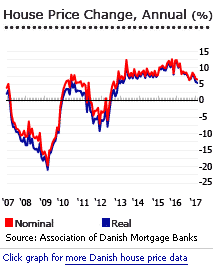 Negative interest rates continue to work their dangerous magic. In Denmark they actually pay you to borrow money, and the IMF is not happy with the effects on the property market. During the year to February 2017, the price index of owner-occupied flats in Denmarkrose by 6.5% (5.45% when adjusted for inflation), according to Statistics Denmark. During the latest quarterhouse prices rose by 3.19% (2.38% inflation-adjusted).
Negative interest rates continue to work their dangerous magic. In Denmark they actually pay you to borrow money, and the IMF is not happy with the effects on the property market. During the year to February 2017, the price index of owner-occupied flats in Denmarkrose by 6.5% (5.45% when adjusted for inflation), according to Statistics Denmark. During the latest quarterhouse prices rose by 3.19% (2.38% inflation-adjusted).
- The average price of owner-occupied flats stood at DKK24,550 (EUR3,300) per square metre (sq. m).
- Detached/terraced houses were priced at an average of DKK12,482 (EUR1,678) per sq. m.
- Holiday homes were priced at an average of DKK13,848 (EUR1,861) per sq. m.
By region, during 2016:
- In the Capital region, i.e. Copenhagen and its hinterland, the average price of owner-occupied flats rose by 9% y-o-y to DKK30,858 (EUR4,148) per sq. m.
- In Zealand region, house prices rose by 1o% y-o-y to an average of DKK14,884 (EUR2,001) per sq. m.
- In Southern Denmark, house prices increased modestly by 3.9% to an average of DKK14,093 (EUR1,894) per sq. m.
- In Central Denmark, house prices increased 6.8% y-o-y to DKK20,870 (EUR2,805) per sq. m.
- In North Zutland, house prices rose by 6.9% y-o-y to an average of DKK16,573 (EUR2,228) per sq. m.
The International Monetary Fund (IMF) recently urged the Danish government to reverse its negative interest rates mandate and introduce new policies, such as zoning rules and relaxing rental market regulations, to avoid a disastrous housing bubble.
“We strongly encourage the authorities to take early action to lean against the wind on house price increases,” said David Hofman of the IMF.
However a recent study by Simon Juul Hviid of Danmarks NationalBank, Denmark’s central bank, concludes that the house price increases in Copenhagen from 2012 to 2016 were mainly driven by fundamental economic factors and not by speculative behavior.
Danish house prices are expected to continue rising this year.
“We expect the housing market will continue to grow overall, with house prices rising 3.5% this year and next,” said Danske Bank in its recent report. “We have also noted a recent increase in housing market activity, with the number of apartment and house sales rising and more property showings indicating a solid appetite for home buying going into the spring.”
The Danish economy grew by a meagre 1.1% in 2016, after growing 1.6% in 2015, 1.7% in 2014, 0.9% in 2013, 0.2% in 2012 and 1.3% in 2011, according to the IMF. The economy is expected to expand by 1.7% this year and by another 1.8% in 2018, according to the European Commission.
Mortgage rates below zero
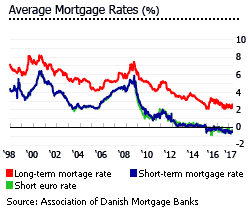
Mortgage interest rates continue to fall. The short-term mortgage rate averaged -0.29% in 2016, down from -0.16% in 2015, 0.19% in 2014, 0.23% in 2013, and 0.47% in 2012, according to the Association of Danish Mortgage Banks (ADMB). Likewise, the long-term mortgage rate also dropped to 2.57% in 2016, from 2.77% in 2015, 3.08% in 2014, 3.48% in 2013, and 3.67% in 2012.
Danmarks NationalBank’s interest rate on certificates of deposit remained unchanged at -0.65%, after an increase of 10 basis points in January 2016. The lending rate, discount rate and the current account rate have been unchanged at 0.05%, 0%, and 0%, respectively.
During the first 20 weeks of 2017, the short-term mortgage rate fell to an average of -0.52% while the long-term mortgage rate dropped to 2.36%.
The Danish mortgage market looks healthy, judging by the low default rate
The size of the mortgage market was equivalent to 127.3% of GDP in 2016, down from 128.3% of GDP in 2015 and the lowest level since 2008. Total mortgages outstanding have risen by just an average of 2.3% annually from 2009 to 2016, after an annual growth of 7.8% from 1998 to 2008.
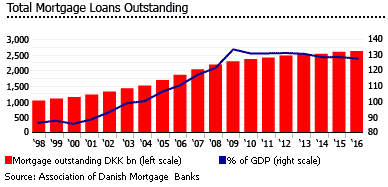
In Q1 2017, total mortgage outstanding stood at DKK2.64 trillion (EUR354.8 billion), up by 1.5% from the same period last year, according to the ADMB.
Mortgage arrears fell to an average of 0.2% in 2016, down from 0.23% in 2015 and the lowest level since 2007, based on figures from ADMB. Likewise, the total number of repossessed dwellings dropped 28.4% y-o-y to just 139 units in Q1 2017 – the lowest level in eight years.
High household debt not a threat to financial stability, says Danmarks NationalBank
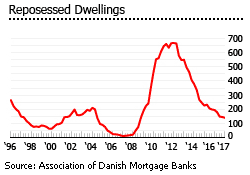
While household debt has continuously fallen in the past six years, the Danes remain the most indebted people in the OECD. Danish households’ average personal debt equals 305% of income, down from 311% in 2013, 313% in 2012, 320% in 2011, 325% in 2010, and 339% in 2009, according to the Organisation for Economic Cooperation and Development (OECD).
Huge debts can put a strain on household finances, thereby negatively affecting the borrowers’ ability to satisfy their loan repayments. Worse, any rise in interest rates will further increase household burden. Despite this, Danish households’ substantial debt is not a serious threat to financial stability, according to Danmarks NationalBank. Most Danish households have sufficient income to handle rising interest rates.
“The vast majority of households with high debt levels are financially robust, and as far as mortgage debt is concerned, the repayment ability of households has proved to be robust,” says Danmarks NationalBank.
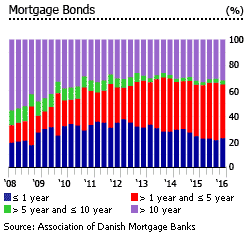
Despite the central bank’s assurance, others remain worried. No less than 57% of Danish mortgages have long interest-only periods, up from only 10% in 2004. Adjustable-rate mortgages were 67% of all mortgages in 2016, up from 38% a decade ago. Danes are paying down mortgages at a rate of only 2% a year on average, and their monthly payments rise sharply when the interest-only periods end (typically ten years into the loan). Refinancing is an option for many, but not for the most precarious borrowers, due to legal restrictions on loans of more than 80% of a property’s value, according to the Economist.
Denmark’s US$550 billion mortgage bond market might be heading for a “potential crisis”, if interest rates substantially increase. Rating companies are worried. The share of bonds with maturities of less than five years has increased to 65% in Q1 2017 from 47.5% in 2008, based on figures from the Association of Danish Mortgage Banks (ADMB). The mismatch means that some bonds must be rolled over each year.
Housing boom and bust
Denmark has been through several vigorous boom-bust cycles recently. Property prices in Denmark peaked in Q2 2007, after huge rises during 2003-2007:
- Prices in the capital region rose by 88.3% (75.6% in real terms), from Q1 2003 to Q2 2007.
- The national average rose 75.4%, or 63.6% in real terms (figures from the Association of Danish Mortgage Banks).
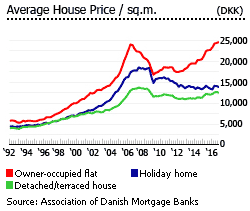
Property prices then fell about 15.4% (-19.3% inflation-adjusted) from Q2 2007 to Q3 2009 due to the global financial meltdown, pushing the economy into recession. In the capital regionthe decline was 25.3%(-28.8% real). The regions that experienced the highest price rises during the boom generally had the biggest price falls.
After a short-lived recovery (Q3 2009 to Q3 2010), property prices again fell by about 9% from Q4 2010 to Q4 2012, due to the eurozone debt crisis.
The housing market has gradually recovered since then.
- In 2013, house prices rose by 1.38% (0.71% in real terms)
- In 2014, house prices rose by 1.83% (1.35% in real terms)
- In 2015, house prices rose by 6.57% (6.17% in real terms)
- In 2016, house prices rose by 3.73% (3.35% in real terms)
Rental yields moderate to good, despite a highly regulated market
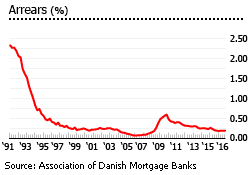
Yields have recovered in Denmark in recent years, as rents have risen faster than house prices. Average gross rental yields in Copenhagen typically range from 4.84% to 5.31%, according to Global Property Guide research.Unsurprisingly, smaller apartments offer higher rental yields. Apartments of 120 square metres (sq. m.) yield 4.84% while apartments of 50 sq. m. yield 5.27%.
Nevertheless, few new private rental dwellings are now being built, largely because the private rental market is strongly pro-tenant (see Landlord and Tenant section).
Only rental dwellings constructed after 1991 are exempt from rent control (less than 1% of dwelling stock, or about 10,000 to 15,000 units). Otherwise rents are non-responsive to market forces because there are five different forms of rent control, depending upon the age of the building. There is also a huge social rental sector.
Further discouraging landlordism, owner-occupied dwellings receive generous benefits from the government. Aside from mortgage tax relief, house owners are also entitled to a standard deduction for home maintenance. About 21% of households in Denmark receive housing subsidies from the government, the highest rate in the EU. Although there has been a slight decline in owner-occupancy in favour of social housing, this is due to the rise of single person households.
Demand is rising
Demand recovered strongly during the first two months of 2017, with registered sales rising by 4.9% y-o-y for one-family houses and by 12.9% y-o-y for owner-occupied dwellings.
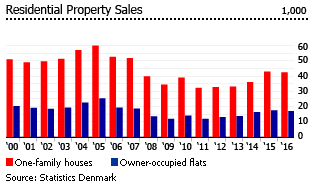
However the time-on-market to sell a house remains high:
- Detached/terrace house average days-on-market decreased to 192 in Q4 2016, down from 204 days a year earlier.
- Owner-occupied flat average days-on-market were 116 in Q4 2016, up from 115 days a year earlier.
- Holiday home average days-on-market were 316 in Q4 2016, up from 301 days a year earlier.
Many new developments in Copenhagen
Nationally, residential construction permits, starts, and completions all fell during the first quarter of 2017:
- Residential construction permits fell by 2.2% y-o-y to 5,285 in Q1 2017, according to Statistics Denmark.
- Starts plunged by 29.3% y-o-y.
- Completions fell by 3.9% y-o-y.
Yet despite the countrywide slowdown, Copenhagen itself has seen record construction growth. In 2016, a record 4,300 residential buildings were built in the capital city, the highest level since registration began in 1990.
In recent years, new designated development areas have been built close to the centre of Copenhagen.
- Ørestad – Situated between the city centre, the airport, and the Øresund Bridge, Ørestad is a new business and residential district measuring 3.1 million sq. m. The city’s main convention centre, some of the region’s largest hotels, universities, and multinational corporations are located in Ørestad. It is now home to around 10,000 residents.
- Carlsberg City District – Situated in the centre of Copenhagen, Carlsberg has new houses, schools and offices, mixed with historical buildings. Some current projects include Bohr’s Tower (88 apartments), Ottilia House (27 residences), Jacobsen House (exclusive residences).
- Nordhavn – Previously an industrial and commercial harbour, Nordhavn is being converted into a residential and commercial district. Schools, day care centres, and sport facilities are also being developed.
Other parts of Copenhagen experiencing an upsurge in construction include the southern part of Copenhagen Harbour, the eastern area of Amager, and the southwestern part of the Capital.
Meagre economic growth
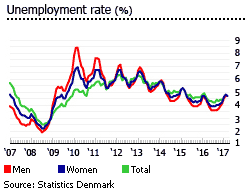
In 2008, Denmark was one of the first countries in Europe to go into recession. The economy contracted by 0.5% in 2008 and by 4.9% in 2009.
Boosted by government spending and the global recovery, Denmark’s GDP growth recovered. But the previous prime minister Helle Thorning-Schmidt, a Social Democrat,adopted austerity measures that improved government finances, and the country recorded a public budget surplus of 1.4% of GDP in 2014, after deficits of 1% in 2013, 3.5% in 2012, 2.1% in 2011, 2.7% in 2010 and 2.8% in 2009.
Mrs Thorning-Schmidt’s measures, which successfully improved the country’s finances, were however unpopular, resulting in her party’s defeat in 2015 and her resignation. In June 2015, Lars Lokke Rasmussen leader of the centre-right liberal party, Venstre, returned for his second innings as Denmark’s PM, and ironically adopted inflationary policies. Spending increases over the past two years in an effort to prop up the economy haveresulted in a budget deficit of 1.3% of GDP in 2015 and 0.9% of GDP in 2016.Denmark’s budget deficit is projected at 1.3% of GDP this year.
The economy is expected to expand by 1.7% this year and by another 1.8% in 2018, according to the European Commission.
In April 2017, the nationwide inflation stood at 1.1%, the highest in the past four years. Inflation slowed sharply to almost zero last year, from 0.2% in 2015, 0.4% in 2014, 0.8% in 2013 and an average of 2.2% from 2000 to 2012. Inflation is expected to hit 1.4% this year and 1.7% in 2018, according to the European Commission.
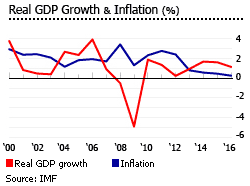
Denmark’s unemployment was 4.7% in March 2017, down from 4.8% in the previous month but up from 4.5% a year earlier, according to Statistics Denmark. Over the same period, unemployment for both men and women stood at 4.7%. Overall unemployment had averaged 4.9% from 2007 to 2016.
There were about 116,276 unemployed persons (seasonally-adjusted) in the country in March 2017, up by 3.5% from 112,398 persons in the same period last year, based on figures from Statistics Denmark.
Gross public debt stood at 37.8% of GDP in 2016, down from 39.6% of GDP in 2015, and 44.8% of GDP in 2014. The country’s public debt is projected to decline to further to 36.7% of GDP this year, according to the European Commission.
Denmark is not open to foreign buyers
Despite Denmark’s association with liberalism, it is not easy to acquire property here.
Nonresidents may not purchase real property here unless the person:
- Has previously resided in Denmark for at least five years;
- Is an EU national working in Denmark; or,
- If a non-EU national, has a valid residence or business permit.
There are some special restrictions on foreign ownership in some areas, especially when buying summer holiday homes. This is particularly prevalent in coastal areas. These are popularly known as the ‘anti-German rules’; because they are designed to prevent coastal areas from being overrun by German second home owners.
However, the purchase of “all-year-round” properties, which are not located in popular areas along the coast, is possible as long as you satisfy the aforementioned requirements.